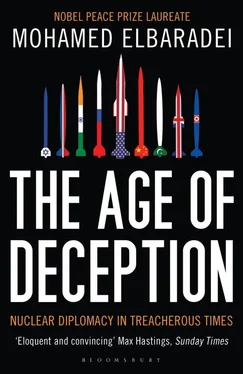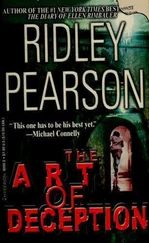Naturally, given Iran’s past practice of concealment and deception, matters such as the P-2 testing and the demolition of an alleged WMD site immediately raised suspicions. The situation was complex. Overall, Iran had made significant steps forward in its cooperation with the IAEA; since October 2003, because of Iran’s provisional implementation of its Additional Protocol, we had been able to visit enrichment and other facilities without disputes over whether nuclear material had been used. We felt that we were at last getting a fuller understanding of Iran’s nuclear activities.
But in other ways, Iran was doing itself no favors with actions that made its cooperation appear sporadic. The Agency had scheduled a mid-March inspection of the Pilot Fuel Enrichment Plant at Natanz and visits to locations related to P-2 centrifuge activity. On March 5 the Iranian authorities abruptly postponed the IAEA inspections on the grounds of the approaching Iranian New Year holidays. Of course, this was nonsense: the timing of the new year was not exactly unforeseen, but Tehran seemed unwilling to disclose the real reason for the delay. Once again, the Iranians gave the impression that they had something to hide.
Against this backdrop, Hassan Rowhani came to see me twice to ask that the Agency take Iran’s nuclear program off the agenda of the March IAEA Board meeting. This, Iran hoped, would be seen as a signal that our level of concern had lessened. The Europeans came to support Iran’s request. The French delegation asked why I would issue a new report on Iran. However, the Americans, who were pressing to refer Iran to the Security Council, were adamant that the agenda item should remain.
I told each delegation the same thing: the Board agenda would not be used as a tool for political negotiation. The contents were a reflection of technical judgment. “I will be happy to remove the agenda item tomorrow,” I said to the Iranians and the Europeans, “but only if the outstanding issues in Iran have been resolved. As long as we still have unanswered questions, the Iranian nuclear program will remain on the Board agenda.”
In any case, the official instrument for IAEA Member States to register their position on Iran’s nuclear program was not the agenda, but the resolutions adopted at Board meetings. Customarily, resolutions are drafted and negotiated by Member State representatives, without any involvement from the Secretariat. In the case of Iran, the drafts usually originated with the EU-3, given their initiative in trying to find a solution, and were then circulated to other countries.
But here, too, the process was a mess. There was an unprecedented split among the Western countries. The Americans, backed by the Canadians and Australians, were calling for the inclusion of strong language condemning Iran. The EU-3 were trying to tone down the resolution. In Iran, the nuclear negotiators had been proclaiming to the Iranian press and political establishment the benefits of expanded cooperation with the IAEA, so they stood to lose domestic support if the IAEA Board issued a negative resolution. The developing countries were also unhappy with the language of the initial draft.
In an unusual step, the Iranians urged me to help. The American ambassador also delivered a message from Colin Powell asking whether I could become involved. In the end, everyone signed off on a consensus resolution that pleased both the Iranians and the Americans. The meeting went off without a hitch, but the wrangling that preceded it demonstrated the degree to which Board actions were becoming a staging ground for showdowns over Iran and presaged deeper divisions yet to come.
A few days after the Board meeting, I headed to Washington to see President Bush. I had been a bit surprised at the invitation. I had recently published an essay on disarmament in the New York Times that covered topics on which Bush had also weighed in. [11] Both my op-ed and Bush’s speech, at the National Defense University, reflected an emerging awareness of the clandestine nuclear supply network of A. Q. Khan and his cohorts. A fuller discussion appears in chapter 7.
Colin Powell called soon after, saying that Bush wanted to meet with me. Naturally I said yes but waited until after the March Board meeting to avoid the appearance of U.S. influence on my report to the Board or on any statements I might make.
Prior to my meeting with Bush, I talked to Richard Armitage, deputy secretary of state. He reminded me of the overture of goodwill that the United States had made to Iran after the devastating December 2003 earthquake in Bam. [12] The December 26 earthquake in southeastern Iran, the most devastating quake in Iranian history, killed more than twenty-five thousand people, with tens of thousands more injured and homeless.
The plan had been to provide Iran with humanitarian assistance, an offer that was declined, although Iran reversed itself days later. Coincidentally, the earthquake occurred only a week after Iran had signed its Additional Protocol, a significant concession. Some commentators noted that perhaps the convergence of these events presented an opportunity for a thaw in U.S.-Iranian relations, particularly after Colin Powell had spoken favorably about the possibility of future dialogue. [13] Paul Reynolds, “The Politics of Earthquakes,” BBC News Online, December 30, 2003.
But so far there had been no further signs of a thaw.
“So, I heard you’re a Yankees fan” was one of the first things Bush said to me. We were in the Oval Office. Bush was accompanied by Armitage, Rice, Secretary of Energy Spencer Abraham, and Bob Joseph, who worked with Rice at the National Security Council. I was accompanied by David Waller, the IAEA’s American deputy director general for management and a trusted friend.
“Yes,” I said, grinning, “and I think we might have paid too much for Alex Rodriguez.” The Yankees had just acquired Rodriguez from the Texas Rangers. Bush, I knew, had been co-owner of the Rangers. He explained a few of the terms of the Rodriguez deal, and we soon turned to business. “I hear you have ideas about strengthening the nonproliferation regime,” he began.
I rattled off some of the concepts I had talked about in my op-ed. “We first need to get rid of all the high-enriched uranium that exists in the civilian cycle,” I said. I mentioned that there were roughly a hundred facilities in forty countries with HEU. Many of these were research reactors, which could be converted to use low-enriched uranium, thus lowering the proliferation risk. Securing all of the HEU, I told Bush, would take about fifty million dollars per year over four or five years.
“Well, that doesn’t sound like much,” Bush responded. He looked at Spencer Abraham. “Spence, is this doable?”
“Yes, of course we can do it,” Abraham replied. As I would later find out, the Department of Energy was already working on a related plan, but following this meeting they got their marching orders from the president.
I talked about the need to control the spread of fuel cycle facilities, noting that there were thirteen countries with either reprocessing or enrichment capabilities. “If we try to prevent others from joining this group,” I said, “those who are on the verge of acquiring the capabilities will not be very happy.” This comment brought us to the question of Iran. The discussion was going well, so I decided to be bold. “In my view,” I said, “theology apart, ideology apart, we need to buy Iran off”—with a package of incentives too attractive to pass up—“and then push for a voluntary moratorium on any additional countries developing a fuel cycle.”
“I like this pragmatic guy,” Bush declared, surprising me. He said he would like to enact a legal cutoff, allowing those countries with fuel cycle facilities to maintain them but prohibiting new countries from entering the mix. I pointed out that this would deny Member States their rights granted under the NPT. Success would be more likely by combining a voluntary moratorium with assurances of fuel supplies—and, I reminded Bush, a reaffirmation by nuclear-weapon states of their commitment to disarmament. [14] In my October 2003 article in the Economist , I had made clear my view that bringing fuel cycle facilities under multinational control was only one step in a process that would ultimately lead toward nuclear disarmament.
Regarding Iran, I emphasized the need to offer not only threats but also rewards. “A solution based on diplomacy and verification,” I concluded, “is the best possible outcome for the Iranian issue.”
Читать дальше












